
Illustrative Math Alignment: Grade 7 Unit 7
Angles, Triangles, and Prisms
Lesson 6: Building Polygons (Part 1)
Use the following Media4Math resources with this Illustrative Math lesson.
| Thumbnail Image | Title | Body | Curriculum Nodes |
|---|---|---|---|
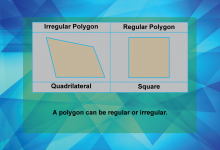
|
Math Clip Art--Geometry Basics--Polygon Basics 05 | Math Clip Art--Geometry Basics--Polygon Basics 05TopicGeometry Basics DescriptionThis image is part of a series designed to teach fundamental concepts about polygons. It showcases an irregular quadrilateral alongside a regular quadrilateral, reinforcing the concept that polygons can be either regular or irregular. This visual comparison helps students understand the distinction between these two categories of quadrilaterals. |
Definition of a Polygon |
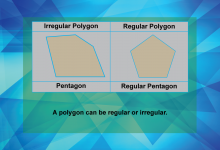
|
Math Clip Art--Geometry Basics--Polygon Basics 06 | Math Clip Art--Geometry Basics--Polygon Basics 06TopicGeometry Basics DescriptionThis image is part of a series designed to teach fundamental concepts about polygons. It presents a comparison between an irregular pentagon and a regular pentagon, further reinforcing the concept that polygons can be either regular or irregular. This visual representation helps students understand how these classifications apply to more complex polygons. |
Definition of a Polygon |

|
Math Clip Art--Geometry Basics--Polygon Basics 07 | Math Clip Art--Geometry Basics--Polygon Basics 07TopicGeometry Basics DescriptionThis image is part of a series designed to teach fundamental concepts about polygons. It showcases an irregular hexagon alongside a regular hexagon, further emphasizing the concept that polygons can be either regular or irregular. This visual comparison helps students extend their understanding of polygon classifications to shapes with even more sides. |
Definition of a Polygon |

|
Math Clip Art--Geometry Basics--Polygon Basics 08 | Math Clip Art--Geometry Basics--Polygon Basics 08TopicGeometry Basics DescriptionThis image is part of a series designed to teach fundamental concepts about polygons. It illustrates a polygon with its interior angles labeled, demonstrating that the sum of these angles relates to the number of sides. This visual representation helps students understand the relationship between a polygon's structure and its angular properties. |
Definition of a Polygon |
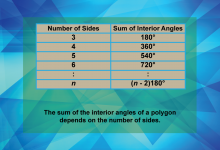
|
Math Clip Art--Geometry Basics--Polygon Basics 09 | Math Clip Art--Geometry Basics--Polygon Basics 09TopicGeometry Basics DescriptionThis image is part of a series designed to teach fundamental concepts about polygons. It presents a table that illustrates the relationship between the number of sides in a polygon, the number of triangles that can be formed within it, and the sum of its interior angles. The caption emphasizes that the sum of interior angles depends on the number of sides, reinforcing this crucial geometric principle. |
Definition of a Polygon |
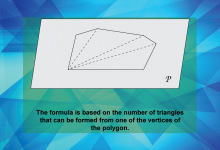
|
Math Clip Art--Geometry Basics--Polygon Basics 10 | Math Clip Art--Geometry Basics--Polygon Basics 10TopicGeometry Basics DescriptionThis image is part of a series designed to teach fundamental concepts about polygons. It features an illustration of a polygon with its exterior angles highlighted, accompanied by a caption stating that the sum of the interior angles of a polygon is based on the number of triangles that can be formed. This visual representation helps students understand a key property of polygons that remains constant regardless of the number of sides. |
Definition of a Polygon |

|
Math Clip Art--Geometry Basics--Regular Polygon 01 | Math Clip Art--Geometry Basics--Regular Polygon 01TopicGeometry Basics DescriptionThis math clip art image serves as the introductory title card for a series on regular polygons. The simple yet effective design features the words "Regular Polygons" prominently displayed, setting the stage for the educational content to follow. This image is crucial in capturing students' attention and clearly establishing the topic of study. |
Definition of a Polygon |
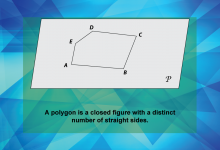
|
Math Clip Art--Geometry Basics--Regular Polygon 02 | Math Clip Art--Geometry Basics--Regular Polygon 02TopicGeometry Basics DescriptionThis math clip art image is the second in a series about regular polygons, focusing on the fundamental definition of a polygon. The illustration showcases a general polygon shape, accompanied by a clear, concise caption that defines a polygon as a closed figure with a distinct number of straight sides. |
Definition of a Polygon |

|
Math Clip Art--Geometry Basics--Regular Polygon 03 | Math Clip Art--Geometry Basics--Regular Polygon 03TopicGeometry Basics DescriptionThis math clip art image is the third in a series about regular polygons, introducing the specific definition of a regular polygon. The illustration features a regular pentagon, accompanied by a caption explaining that a regular polygon has congruent sides and congruent angles. |
Definition of a Polygon |
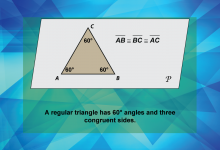
|
Math Clip Art--Geometry Basics--Regular Polygon 04 | Math Clip Art--Geometry Basics--Regular Polygon 04TopicGeometry Basics DescriptionThis math clip art image is the fourth in a series about regular polygons, focusing on the equilateral triangle. The illustration presents a clear example of an equilateral triangle, accompanied by a caption highlighting its key properties: 60° angles and three congruent sides. |
Definition of a Polygon |

|
Math Clip Art--Geometry Basics--Regular Polygon 05 | Math Clip Art--Geometry Basics--Regular Polygon 05TopicGeometry Basics DescriptionThis math clip art image serves as a title card for the process of constructing a regular triangle. It introduces a new section in the series on regular polygons, shifting focus from definitions and properties to the practical application of geometric principles. |
Definition of a Polygon |
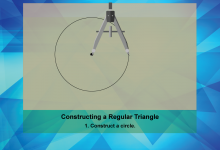
|
Math Clip Art--Geometry Basics--Regular Polygon 06 | Math Clip Art--Geometry Basics--Regular Polygon 06TopicGeometry Basics DescriptionThis math clip art image is the sixth in the series about regular polygons and the first step in constructing a regular triangle. It illustrates the initial stage of the construction process, showing a compass being used to draw a circle. The caption clearly states that this is Step 1 in constructing a regular triangle. |
Definition of a Polygon |

|
Math Clip Art--Geometry Basics--Regular Polygon 07 | Math Clip Art--Geometry Basics--Regular Polygon 07TopicGeometry Basics DescriptionThis math clip art image is the seventh in the series about regular polygons and represents Step 2 in constructing a regular triangle. The illustration shows a line drawn through the center of the circle created in the previous step. This step is crucial in establishing the base for the equilateral triangle. |
Definition of a Polygon |
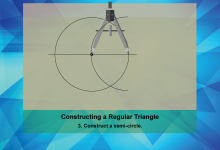
|
Math Clip Art--Geometry Basics--Regular Polygon 08 | Math Clip Art--Geometry Basics--Regular Polygon 08TopicGeometry Basics DescriptionThis math clip art image is the eighth in the series about regular polygons and illustrates Step 3 in constructing a regular triangle. The image shows the construction of a semi-circle using the compass, building upon the previous steps of drawing a full circle and a line through its center. |
Definition of a Polygon |

|
Math Clip Art--Geometry Basics--Regular Polygon 09 | Math Clip Art--Geometry Basics--Regular Polygon 09TopicGeometry Basics DescriptionThis math clip art image is the ninth in the series about regular polygons and represents Step 4 in constructing a regular triangle. The illustration highlights the centers used in the previous construction steps, emphasizing their importance in the process. |
Definition of a Polygon |
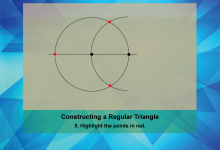
|
Math Clip Art--Geometry Basics--Regular Polygon 10 | Math Clip Art--Geometry Basics--Regular Polygon 10TopicGeometry Basics DescriptionThis math clip art image is part of a series on regular polygons, focusing on the construction of an equilateral triangle. The illustration shows Step 5 of the process, where key points are highlighted in red. This visual aid is crucial in guiding students through the precise steps of geometric construction. Using math clip art like this in geometry lessons helps students visualize abstract concepts and follow complex procedures. It bridges the gap between theoretical knowledge and practical application, making the learning process more engaging and effective. |
Definition of a Polygon |
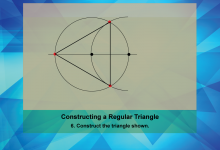
|
Math Clip Art--Geometry Basics--Regular Polygon 11 | Math Clip Art--Geometry Basics--Regular Polygon 11TopicGeometry Basics DescriptionThis math clip art image continues the series on regular polygons, illustrating Step 6 in constructing an equilateral triangle. The image shows the actual construction of the triangle based on the points and arcs established in previous steps. This visual representation is essential in demonstrating how geometric principles come together to form regular shapes. |
Definition of a Polygon |

|
Math Clip Art--Geometry Basics--Regular Polygon 12 | Math Clip Art--Geometry Basics--Regular Polygon 12TopicGeometry Basics DescriptionThis math clip art image is part of the series on regular polygons, focusing on Step 7 of constructing an equilateral triangle. The illustration emphasizes the congruent sides of the newly constructed triangle, a key characteristic of equilateral triangles. This visual aid is crucial in helping students understand the defining properties of regular polygons. |
Definition of a Polygon |
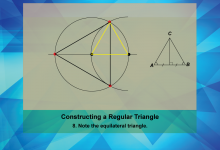
|
Math Clip Art--Geometry Basics--Regular Polygon 13 | Math Clip Art--Geometry Basics--Regular Polygon 13TopicGeometry Basics DescriptionThis math clip art image is part of the series on regular polygons, illustrating Step 8 in the construction of an equilateral triangle. The image emphasizes the completed equilateral triangle, showcasing the result of the step-by-step construction process. This visual representation is crucial in reinforcing the concept of regular polygons and their properties. |
Definition of a Polygon |
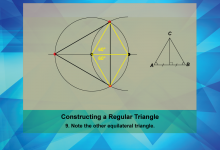
|
Math Clip Art--Geometry Basics--Regular Polygon 14 | Math Clip Art--Geometry Basics--Regular Polygon 14TopicGeometry Basics DescriptionThis math clip art image continues the series on regular polygons, focusing on Step 9 of constructing an equilateral triangle. The illustration points out another equilateral triangle formed during the construction process. This visual aid is essential in demonstrating how geometric constructions can yield multiple regular shapes simultaneously. |
Definition of a Polygon |
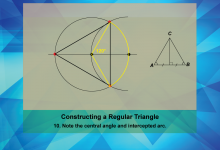
|
Math Clip Art--Geometry Basics--Regular Polygon 15 | Math Clip Art--Geometry Basics--Regular Polygon 15TopicGeometry Basics DescriptionThis math clip art image is part of the series on regular polygons, illustrating Step 10 in the construction of an equilateral triangle. The image highlights the central angle and its intercepted arc within the construction. This visual aid is crucial in demonstrating the relationship between central angles and regular polygons. |
Definition of a Polygon |
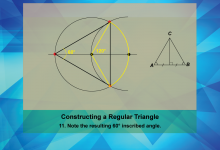
|
Math Clip Art--Geometry Basics--Regular Polygon 16 | Math Clip Art--Geometry Basics--Regular Polygon 16TopicGeometry Basics DescriptionThis math clip art image continues the series on regular polygons, focusing on Step 11 of constructing an equilateral triangle. The illustration highlights the resulting 60° inscribed angle within the construction. This visual aid is essential in demonstrating the relationship between inscribed angles and central angles in a circle. |
Definition of a Polygon |
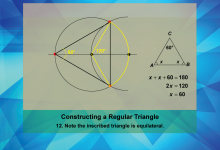
|
Math Clip Art--Geometry Basics--Regular Polygon 17 | Math Clip Art--Geometry Basics--Regular Polygon 17TopicGeometry Basics DescriptionThis math clip art image is part of the series on regular polygons, illustrating Step 12 in the construction of an equilateral triangle. The image emphasizes that the inscribed triangle within the circle is equilateral. This visual representation is crucial in demonstrating how circular properties guarantee the formation of a regular polygon. |
Definition of a Polygon |
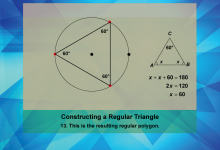
|
Math Clip Art--Geometry Basics--Regular Polygon 18 | Math Clip Art--Geometry Basics--Regular Polygon 18TopicGeometry Basics DescriptionThis math clip art image concludes the series on constructing a regular triangle, showcasing the final result of the step-by-step process. The illustration presents the completed equilateral triangle as the simplest regular polygon. This visual representation is essential in summarizing the construction process and reinforcing the concept of regular polygons. |
Definition of a Polygon |
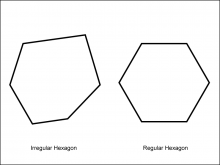
|
Math Clip Art--Geometry Concepts--Polygons--Hexagon | Math Clip Art--Polygons--HexagonTopicGeometry Concepts DescriptionThis image illustrates two hexagons: one regular and one irregular. A hexagon is a six-sided polygon. In a regular hexagon, all sides and angles are equal, with each interior angle measuring 120 degrees. This symmetry gives it a balanced and uniform appearance. An irregular hexagon, by contrast, has sides and angles that are not all equal. This lack of uniformity means that the hexagon can take on a variety of shapes, depending on the specific lengths and angles of its sides. |
Definition of a Polygon |

|
Math Clip Art--Geometry Concepts--Polygons--Octagon | Math Clip Art--Polygons--OctagonTopicGeometry Concepts DescriptionThis image shows two octagons: one regular and one irregular. An octagon is an eight-sided polygon. In a regular octagon, all sides and angles are equal, with each interior angle measuring 135 degrees. This regularity gives it a symmetrical and balanced appearance. An irregular octagon, on the other hand, has sides and angles that are not all equal. This asymmetry means that the octagon can have a variety of shapes, depending on the specific lengths and angles of its sides. |
Definition of a Polygon |
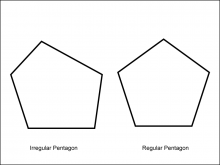
|
Math Clip Art--Geometry Concepts--Polygons--Pentagon | Math Clip Art--Polygons--PentagonTopicGeometry Concepts DescriptionThis image depicts two pentagons: one regular and one irregular. A pentagon is a five-sided polygon. In a regular pentagon, all sides and angles are equal, with each interior angle measuring 108 degrees. This regularity gives it a symmetrical and balanced appearance. An irregular pentagon, however, has sides and angles that are not all equal. This asymmetry allows the pentagon to take on various shapes, depending on the specific lengths and angles of its sides. |
Definition of a Polygon |
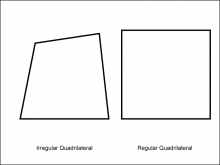
|
Math Clip Art--Geometry Concepts--Polygons--Quadrilateral | Math Clip Art--Polygons--QuadrilateralTopicGeometry Concepts DescriptionThis image illustrates two quadrilaterals: one regular and one irregular. A quadrilateral is a four-sided polygon. In a regular quadrilateral, such as a square, all sides and angles are equal, with each interior angle measuring 90 degrees. This regularity gives it a symmetrical and balanced appearance. An irregular quadrilateral, however, has sides and angles that are not all equal. This asymmetry allows the quadrilateral to take on various shapes, depending on the specific lengths and angles of its sides. |
Definition of a Polygon |
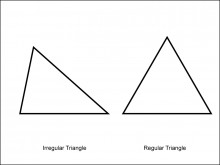
|
Math Clip Art--Geometry Concepts--Polygons--Triangle | Math Clip Art--Polygons--TriangleTopicGeometry Concepts DescriptionThis image shows two triangles: one regular and one irregular. A triangle is a three-sided polygon. In a regular triangle, also known as an equilateral triangle, all sides and angles are equal, with each interior angle measuring 60 degrees. This regularity gives it a symmetrical and balanced appearance. An irregular triangle, however, has sides and angles that are not all equal. This asymmetry allows the triangle to take on various shapes, depending on the specific lengths and angles of its sides. |
Definition of a Polygon |
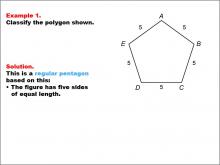
|
Math Example--Polygons--Polygon Classification: Example 1 | Math Example--Polygons--Polygon Classification: Example 1TopicPolygons DescriptionThis example showcases a pentagon with all sides labeled as 5. It demonstrates a regular pentagon, characterized by five sides of equal length. This visual representation helps students understand the concept of regular polygons and their defining characteristics. The topic of polygon classification is crucial in geometry. This collection of examples provides a comprehensive look at various types of pentagons, both regular and irregular. By examining different configurations of sides and angles, students can develop a deeper understanding of polygon properties and classification criteria. |
Definition of a Polygon |
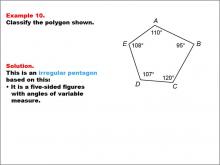
|
Math Example--Polygons--Polygon Classification: Example 10 | Math Example--Polygons--Polygon Classification: Example 10TopicPolygons DescriptionThis example showcases a pentagon labeled with vertices A, B, C, D, E, where the angles are marked as 110°, 95°, 120°, 107°, and 108°. It demonstrates an irregular pentagon based on the variation in angle measures, highlighting that regularity depends on both side lengths and angle measures. Understanding polygon classification is essential in geometry as it helps students recognize and categorize shapes based on their properties. This collection of examples emphasizes the importance of both side lengths and angle measures in determining the regularity of pentagons. |
Definition of a Polygon |
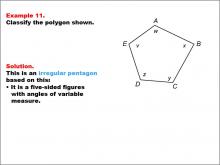
|
Math Example--Polygons--Polygon Classification: Example 11 | Math Example--Polygons--Polygon Classification: Example 11TopicPolygons DescriptionThis example presents a pentagon labeled with vertices A, B, C, D, E, where the sides are marked with variables w, x, y, z, and v. It illustrates an irregular pentagon by using different variables to represent potentially different side lengths, emphasizing that side length variation results in irregularity. Polygon classification is a fundamental concept in geometry that helps students analyze and categorize shapes based on their properties. This collection of examples provides a comprehensive look at various types of pentagons, highlighting the importance of side length equality in determining regularity. |
Definition of a Polygon |
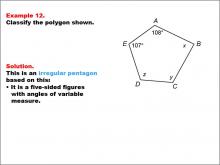
|
Math Example--Polygons--Polygon Classification: Example 12 | Math Example--Polygons--Polygon Classification: Example 12TopicPolygons DescriptionThis example features a pentagon labeled with vertices A, B, C, D, E, where the angles are marked as 108°, x, y, z, and 107°. It demonstrates an irregular pentagon based on the variation in angle measures, highlighting that regularity depends on all angles being equal. Understanding polygon classification is essential in geometry as it helps students recognize and categorize shapes based on their properties. This collection of examples emphasizes the importance of angle measures in determining the regularity of pentagons, showing that even one different angle makes the polygon irregular. |
Definition of a Polygon |
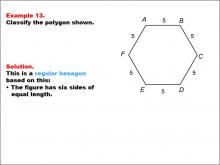
|
Math Example--Polygons--Polygon Classification: Example 13 | Math Example--Polygons--Polygon Classification: Example 13TopicPolygons DescriptionThis example showcases a hexagon with all sides labeled as 5, indicating equal length. It demonstrates a regular hexagon, characterized by six sides of equal length. This visual representation helps students understand the concept of regular polygons and their defining characteristics. The topic of polygon classification is crucial in geometry. This collection of examples provides a comprehensive look at various types of hexagons, both regular and irregular. By examining different configurations of sides and angles, students can develop a deeper understanding of polygon properties and classification criteria. |
Definition of a Polygon |
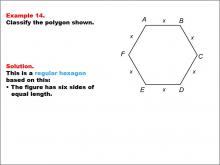
|
Math Example--Polygons--Polygon Classification: Example 14 | Math Example--Polygons--Polygon Classification: Example 14TopicPolygons DescriptionThis example presents a hexagon with all sides labeled as x, indicating equal length. It illustrates another instance of a regular hexagon, reinforcing the concept that a regular polygon has all sides of equal length, even when represented by a variable. Polygon classification is a fundamental topic in geometry that helps students understand the properties and characteristics of different shapes. This collection of examples provides a comprehensive overview of various hexagon types, allowing students to distinguish between regular and irregular polygons based on their side lengths and angle measures. |
Definition of a Polygon |
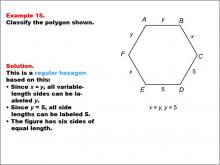
|
Math Example--Polygons--Polygon Classification: Example 15 | Math Example--Polygons--Polygon Classification: Example 15TopicPolygons DescriptionThis example features a hexagon with sides labeled y, x, and 5, showing that x = y = 5, making all sides equal in length. It demonstrates a regular hexagon by using a combination of variables and numeric values to represent equal side lengths. Understanding polygon classification is crucial in geometry as it helps students recognize and categorize shapes based on their properties. This collection of examples highlights different ways to represent regular hexagons, emphasizing the importance of side length equality in classification. |
Definition of a Polygon |
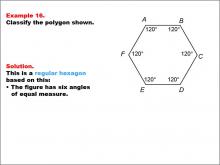
|
Math Example--Polygons--Polygon Classification: Example 16 | Math Example--Polygons--Polygon Classification: Example 16TopicPolygons DescriptionThis example showcases a hexagon with all interior angles labeled as 120 degrees, indicating equal angles. It demonstrates that a regular hexagon can be identified not only by equal side lengths but also by equal angle measures, reinforcing the dual criteria for regularity in polygons. Polygon classification is a fundamental concept in geometry that helps students analyze and categorize shapes based on their properties. This collection of examples provides a comprehensive look at various aspects of regular hexagons, emphasizing both side length and angle measure as defining characteristics. |
Definition of a Polygon |
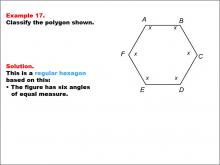
|
Math Example--Polygons--Polygon Classification: Example 17 | Math Example--Polygons--Polygon Classification: Example 17TopicPolygons DescriptionThis example presents a hexagon with six equal sides labeled as x and equal angles, indicating a regular hexagon. It reinforces the concept of a regular polygon by visually representing both the equality of all sides and angles. Understanding polygon classification is essential in geometry as it helps students recognize and categorize shapes based on their properties. This collection of examples provides various representations of regular hexagons, emphasizing the importance of both side length and angle measure equality in classification. |
Definition of a Polygon |
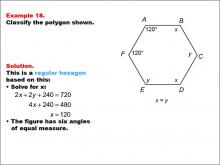
|
Math Example--Polygons--Polygon Classification: Example 18 | Math Example--Polygons--Polygon Classification: Example 18TopicPolygons DescriptionThis example features a hexagon with two angles labeled as 120 degrees and sides labeled x and y, where x = y. It demonstrates how to determine if a hexagon is regular by solving for the unknown angle measures and confirming equal side lengths. Polygon classification is a crucial topic in geometry that helps students distinguish between regular and irregular shapes. This collection of examples provides a comprehensive look at various types of hexagons, highlighting the importance of both angle measures and side lengths in determining regularity. |
Definition of a Polygon |

|
Math Example--Polygons--Polygon Classification: Example 19 | Math Example--Polygons--Polygon Classification: Example 19TopicPolygons DescriptionThis example showcases a hexagon with sides labeled with varying lengths: AB = 6, BC = 4, CD = 6, DE = 3, EF = 6, and FA = 5. It demonstrates an irregular hexagon, emphasizing that side length variation results in irregularity. Understanding polygon classification is crucial in geometry as it helps students recognize and categorize shapes based on their properties. This collection of examples highlights the differences between regular and irregular hexagons, focusing on side length as a key determining factor. |
Definition of a Polygon |
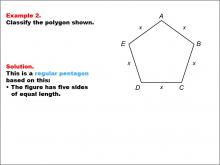
|
Math Example--Polygons--Polygon Classification: Example 2 | Math Example--Polygons--Polygon Classification: Example 2TopicPolygons DescriptionThis example presents a pentagon with all sides labeled as x, indicating equal length. It illustrates another instance of a regular pentagon, reinforcing the concept that a regular polygon has all sides of equal length. Polygon classification is a fundamental topic in geometry that helps students understand the properties and characteristics of different shapes. This collection of examples provides a comprehensive overview of various pentagon types, allowing students to distinguish between regular and irregular polygons based on their side lengths and angle measures. |
Definition of a Polygon |
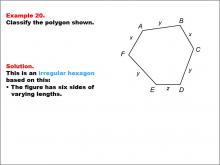
|
Math Example--Polygons--Polygon Classification: Example 20 | Math Example--Polygons--Polygon Classification: Example 20TopicPolygons DescriptionThis example presents a hexagon with sides labeled as x, y, and z, indicating varying lengths. It illustrates another case of an irregular hexagon, demonstrating that the presence of different variables for side lengths suggests irregularity. Polygon classification is a fundamental concept in geometry that helps students analyze and categorize shapes based on their properties. This collection of examples provides a comprehensive look at various types of hexagons, emphasizing the importance of side length equality in determining regularity. |
Definition of a Polygon |
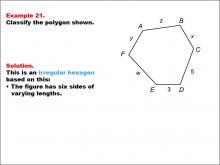
|
Math Example--Polygons--Polygon Classification: Example 21 | Math Example--Polygons--Polygon Classification: Example 21
This is part of a collection of math examples that focus on geometric shapes. |
Definition of a Polygon |

|
Math Example--Polygons--Polygon Classification: Example 22 | Math Example--Polygons--Polygon Classification: Example 22
This is part of a collection of math examples that focus on geometric shapes. |
Definition of a Polygon |

|
Math Example--Polygons--Polygon Classification: Example 23 | Math Example--Polygons--Polygon Classification: Example 23
This is part of a collection of math examples that focus on geometric shapes. |
Definition of a Polygon |
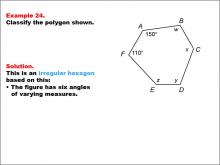
|
Math Example--Polygons--Polygon Classification: Example 24 | Math Example--Polygons--Polygon Classification: Example 24
This is part of a collection of math examples that focus on geometric shapes. |
Definition of a Polygon |
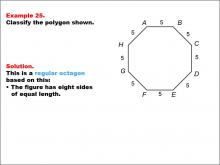
|
Math Example--Polygons--Polygon Classification: Example 25 | Math Example--Polygons--Polygon Classification: Example 25TopicPolygons DescriptionThis example showcases an octagon with all sides labeled as 5, indicating equal length. It demonstrates a regular octagon, characterized by eight sides of equal length. This visual representation helps students understand the concept of regular polygons and their defining characteristics. The topic of polygon classification is crucial in geometry. This collection of examples provides a comprehensive look at various types of octagons, both regular and irregular. By examining different configurations of sides and angles, students can develop a deeper understanding of polygon properties and classification criteria. |
Definition of a Polygon |
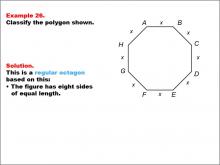
|
Math Example--Polygons--Polygon Classification: Example 26 | Math Example--Polygons--Polygon Classification: Example 26TopicPolygons DescriptionThis example presents an octagon with all sides labeled as x, indicating equal length. It illustrates another instance of a regular octagon, reinforcing the concept that a regular polygon has all sides of equal length, even when represented by a variable. Understanding polygon classification is essential in geometry as it helps students recognize and categorize shapes based on their properties. This collection of examples provides various representations of regular octagons, emphasizing the importance of side length equality in classification. |
Definition of a Polygon |

|
Math Example--Polygons--Polygon Classification: Example 27 | Math Example--Polygons--Polygon Classification: Example 27TopicPolygons DescriptionThis example features an octagon with sides labeled as x, z, and 5, showing that x = z = 5, indicating equal length for all sides. It demonstrates a regular octagon by using a combination of variables and numeric values to represent equal side lengths. Polygon classification is a fundamental concept in geometry that helps students analyze and categorize shapes based on their properties. This collection of examples provides a comprehensive look at various aspects of regular octagons, emphasizing the importance of side length equality in classification. |
Definition of a Polygon |
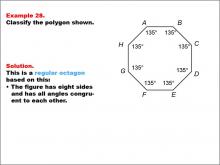
|
Math Example--Polygons--Polygon Classification: Example 28 | Math Example--Polygons--Polygon Classification: Example 28TopicPolygons DescriptionThis example showcases an octagon with all angles labeled as 135 degrees, indicating congruent angles. It demonstrates that a regular octagon can be identified not only by equal side lengths but also by equal angle measures, reinforcing the dual criteria for regularity in polygons. Understanding polygon classification is crucial in geometry as it helps students recognize and categorize shapes based on their properties. This collection of examples highlights different aspects of regular octagons, emphasizing both side length and angle measure as defining characteristics. |
Definition of a Polygon |